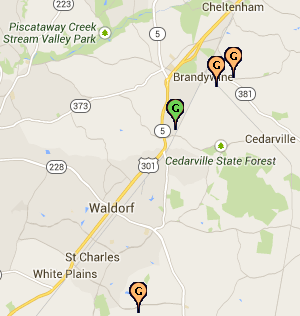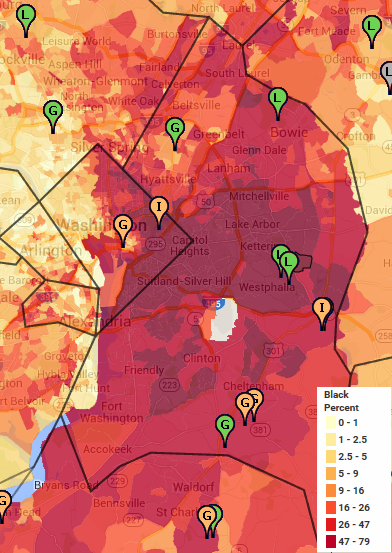Prince George’s County, MD is the wealthiest black county in the nation. Fitting the national trends, certain polluting industries not desired in white communities are overrepresented in the county.
VICTORY! In August, 2016, the county pulled the plug on the "waste-to-energy" contract we've been fighting (described below). See our article on the victory. We're now working on getting the county's plans for zero waste to be done right.
"Waste-to-energy" pursued by Prince George's County: potential trash incinerator near Upper Marlboro?
Upper Marlboro sits between two landfills to the northwest, burning toxic landfill gas that counts as renewable energy in MD and, to the southeast, the sewage treatment plant (with the state's only sewage sludge incinerator). The sludge incinerator, at the sewage treatment plant, has been around since 1971 and burns up to 12 tons of sludge a day.
New trash incinerator? The sludge incinerator site is also the likely site of any new incinerator or trash pelletization plant the county is seeking through the RFQ they put out in late 2014. This is to replace the landfill on the other side of Upper Marlboro, which is scheduled to fill up in 2021.
Instead of expensive and polluting "waste-to-energy" schemes, the county ought to reduce, reuse, recycle and compost at least 90% of its waste. Any remainder should be digested and shipped to area landfills.
Incineration is the dirtiest and most expensive way to manage waste (far worse than landfills). It is also the dirtiest and most expensive way to make energy (worse than coal). Incinerators turn trash into toxic ash and toxic air pollution, harming community health, causing asthma, birth defects, cancer, heart attacks and many other health problems.
TEN TIMES as many jobs can be created with a “zero waste” approach that maximizes reducing waste, repairing and reusing things, recycling and composting.
Get in touch to receive updates, as we add content to this page and alert residents about meetings and opportunities to get involved. Email Don't Burn Prince George's or call 301-836-1405 to get plugged in with local community environmental leaders.
 Gas-fired power plant cluster in Brandywine/Waldorf area:
Gas-fired power plant cluster in Brandywine/Waldorf area:
There is already one large gas-burning power plant in Brandywine, and a large coal and oil-burning power plant in Eagle Harbor (the southeastern corner of the county). On top of this, there is a gas-fired power plant under construction in nearby Charles County plus two more gas-fired power plants planned in Brandywine.
These are all in an area where air quality is already considered unacceptable, as the EPA has declared the counties to be in "non-attainment" for ground-level ozone pollution. This pollution will be made much worse by having more power plants in the area. Breathing ozone can trigger a variety of health problems including chest pain, coughing, throat irritation, and congestion. It can worsen bronchitis, emphysema, and asthma, according to EPA's page on ozone health effects.
The Brandywine/Waldorf region is being targeted for a cluster of 5 fossil fuel power plants. They are:
- The existing 289-megawatt gas-fired Brandywine Panda plant behind Regency Furniture
- The existing 2,647-megawatt Chalk Point coal/oil/gas-fired power plant (burning 72% coal, 27% gas and 1.5% oil)
- The 661-megawatt gas-fired CPV St. Charles plant under construction in Waldorf (approved in 2012) [PSC Docket #9280]
- The proposed (and permitted) 755-megawatt gas-fired Keys Energy Center in Brandywine [PSC Docket #9297]
- The proposed 990-megawatt gas-fired Panda Mattawoman plant behind the current Brandywine Volunteer Fire Station [PSC Docket #9330]
Click on the map for details and like the "Stop 2nd Brandywine Power Plant" Facebook page to stay in the loop (and check "get notifications" under the 'like' button).
To get involved, get in touch with Clean Air Prince George's. To learn more, see our powerpoint and factsheet about gas power plants, and explore our page on natural gas.

